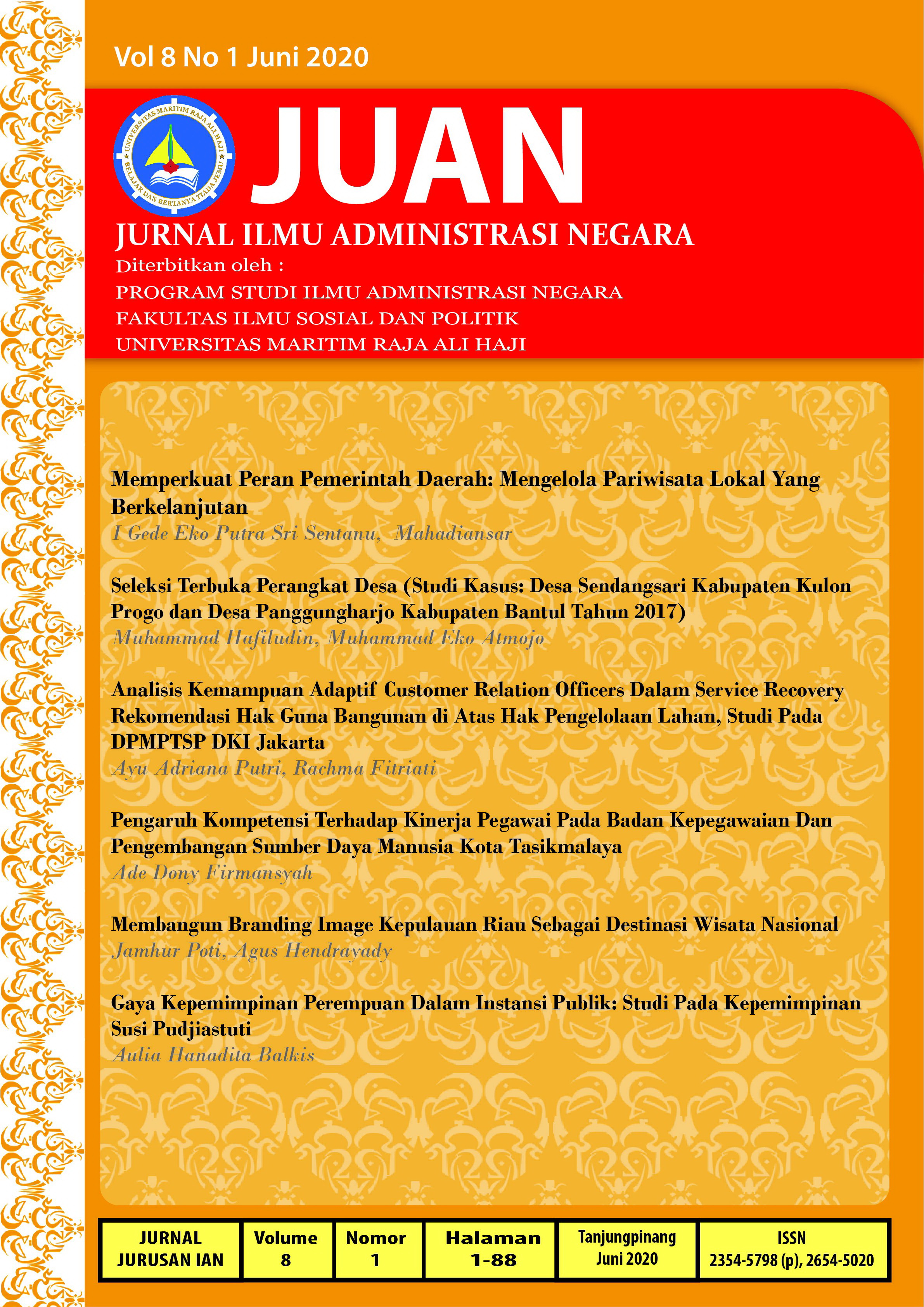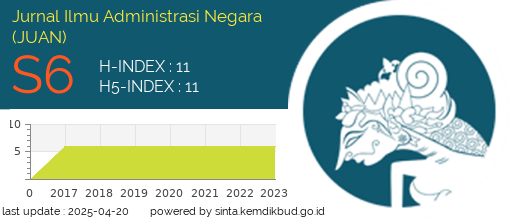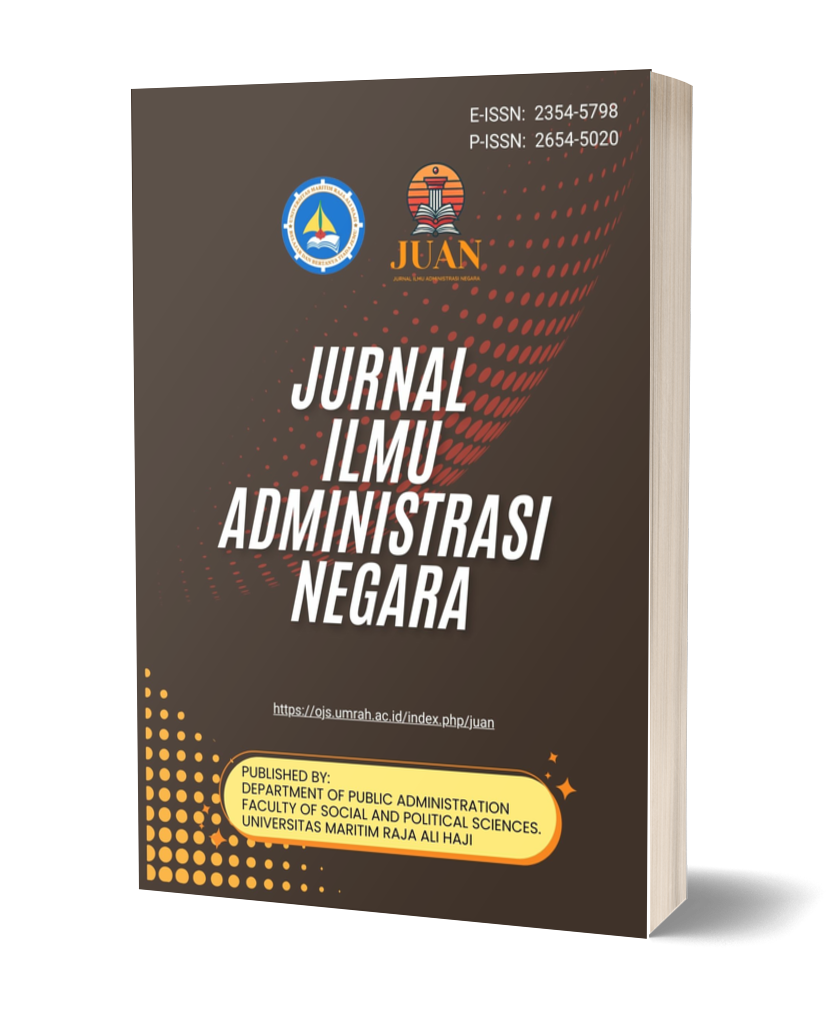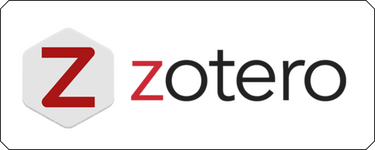Membangun Branding Image Kepulauan Riau sebagai Destinasi Wisata Nasional
DOI:
https://doi.org/10.31629/juan.v8i1.1868Keywords:
Branding Image Kepulauan Riau, Destinasi WisataAbstract
Branding Image bukan hanya sekadar merk dan bukan sekedar logo, brand adalah segalanya bagi sebuah produk. Bagi dunia pariwisata, brand juga sama maknanya, namun brand destinasi harus lahir dari filosofi dan nilai-nilai sebuah destinasi serta keunggulan yang unik. Branding Image akan memberi kekuatan kepada destinasi yang direpresentasi bila brand mendapat proses branding yang baik dan konsisten. Akhir-akhir ini eforia pariwisata Indonesia kadang irrasional dan hanya mengandalkan data sesaat, padahal posisi-posisi Indonesia masih jauh dari yang diharapkan. Sebagai brand destinasi, maka brand harus dibangun berdasarkan realitas sosial yang benar di dalam tergambarkan realitas sosial, yaitu culture, personality, name, logo dan symbol Penelitian ini mencoba mengangkat kajian realitas sosial brand destinasi dengan metode narasi, mencoba membandingkannya dengan kondisi Wonderful Kepri, Wonderful Riau Island sampai Welcome to Batam.. Kepulauan Riau memilik banyak potensi sebagai destinasi wisata nasional maupun internasional, hanya saja belum memiliki daya tarik tersendiri untuk dijual. Untuk menunjang dan memiliki daya saing Kepulauan Riau sebagai destinasi wisata perlu ada sebuah brand yang menjadi Citra sebagai destinasi pariwisata. Suatu Branding yang dikombinasikan dari unsur dan budaya daerah di Kepulauan Riau. Kesimpulan bahwa Kepulauan Riau memerlukan suatu brand atau citra sebagai destinasi wisata nsional agar dapat memberikan pesan bagi wisatawan agar tertarik untuk mengunjungi Kepulauan Riau sebagai salah satu alternatif dari 10 besar sebagai destinasi wisata nasional
Downloads
References
Aarstad, J., Ness, H., & Haugland, S. A. (2015). Network position and tourism firms’ co-branding practice. Journal of Business Research, 68(8), 1667–1677. https://doi.org/10.1016/j.jbusres.2015.03.025
Avraham, E. (2018). Nation branding and marketing strategies for combatting tourism crises and stereotypes toward destinations. Journal of Business Research. https://doi.org/10.1016/j.jbusres.2018.02.036
Bungin, B. (2015). Komunikasi pariwisata (tourism dan communication) : Pemasaran dan brand destinasi. Prena Media.
Chow, H. wen, Ling, G. J., Yen, I. yin, & Hwang, K. P. (2017). Building brand equity through industrial tourism. Asia Pacific Management Review, 22(2), 70–79. https://doi.org/10.1016/j.apmrv.2016.09.001
Creswell, J. W. (2013). Research Design: Qualitative, Quantitative, and Mixed Methods Approaches. In SAGE Publications.
Davis, S. M. (2002). Brand asset management : Driving profitable growth through your brands (2nd ed.). John Wiley & Sons.
Harrigan, P., Evers, U., Miles, M., & Daly, T. (2017). Customer engagement with tourism social media brands. Tourism Management, 59, 597–609. https://doi.org/10.1016/j.tourman.2016.09.015
Karlina, T., & Iskandar, I. (2017). Upaya Indonesia meningkatkan jumlah kunjungan wisatawan mancanegara di Kepulauan Riau. Jurnal Online Mahasiswa Fakultas Ilmu Sosial Dan Ilmu Politik, 4(2), 1–11.
Kartajaya, H. (2007). Elemen marketing on brand. Mizan Pustaka.
Keller, K. L. (2000). The brand report card. Harvard Business Review.
Kotler, Philip., & Armstrong, G. (2006). Principles of marketing. Prentice Hall.
Kovathanakul, D. (2015). Central Northeastern Thailand Tourism Branding, Supporting the ASEAN Economic Community. Procedia Economics and Finance, 23, 291–297. https://doi.org/10.1016/s2212-5671(15)00469-4
Liang, A. R. da, Nie, Y. Y., Chen, D. J., & Chen, P. J. (2020). Case studies on co-branding and farm tourism: Best match between farm image and experience activities. Journal of Hospitality and Tourism Management, 42, 107–118. https://doi.org/10.1016/j.jhtm.2019.11.009
Liu, Y., Hultman, M., Eisingerich, A. B., & Wei, X. (2020). How does brand loyalty interact with tourism destination? Exploring the effect of brand loyalty on place attachment. Annals of Tourism Research, 81. https://doi.org/10.1016/j.annals.2020.102879
Mahadiansar, & Aspariyana. (2020). PEST analysis model dalam pengembangan potensi wisata pulau Benan Kabupaten Lingga Kepulauan Riau. Indonesian Journal of Tourism and Leisure, 1(1), 14–25. https://doi.org/10.36256/ijtl.v1i1.93
Matiza, T., & Slabbert, E. (2020). South Africa’s place brand: A marketing axiom to South Africa as a tourism destination? Journal of Destination Marketing and Management, 15. https://doi.org/10.1016/j.jdmm.2019.100380
Morgan, N., Pritchard, A., & Pride, R. (2011). Destination brands: Managing place reputation. In Place Branding and Public Diplomacy (3rd ed., Vol. 7, Issue 4). Macmillan Publishers. https://doi.org/10.1057/pb.2011.25
Poti, J. (2016). Membangun national branding image Kepulauan Riau sebagai poros maritim dunia. Jurnal Ilmu Administrasi Negara (JUAN), 4(1), 1–13.
Risitano, M. (2005). The role of destination branding in the tourism stakeholders system, The Campi Flegrei case. IV International Doctoral Tourism and Leisure Colloquium, 1–18.
Santos, G. E. de O., & Giraldi, J. de M. E. (2017). Reciprocal effect of tourist destinations on the strength of national tourism brands. Tourism Management, 61, 443–450. https://doi.org/10.1016/j.tourman.2017.03.011
Straub, J. T., & Attner, R. F. (1994). Introduction to business (5th ed.). PWS-Kent.
Wilson, J. S., & Blumenthal, Ira. (2008). Managing brand you : Seven steps to creating your most successful self. American Management Association
Downloads
Published
Issue
Section
License
You are free to:
- Share — copy and redistribute the material in any medium or format for any purpose, even commercially.
- Adapt — remix, transform, and build upon the material for any purpose, even commercially.
- The licensor cannot revoke these freedoms as long as you follow the license terms.
Under the following terms:
- Attribution — You must give appropriate credit, provide a link to the license, and indicate if changes were made . You may do so in any reasonable manner, but not in any way that suggests the licensor endorses you or your use.
- ShareAlike — If you remix, transform, or build upon the material, you must distribute your contributions under the same license as the original.
- No additional restrictions — You may not apply legal terms or technological measures that legally restrict others from doing anything the license permits.













